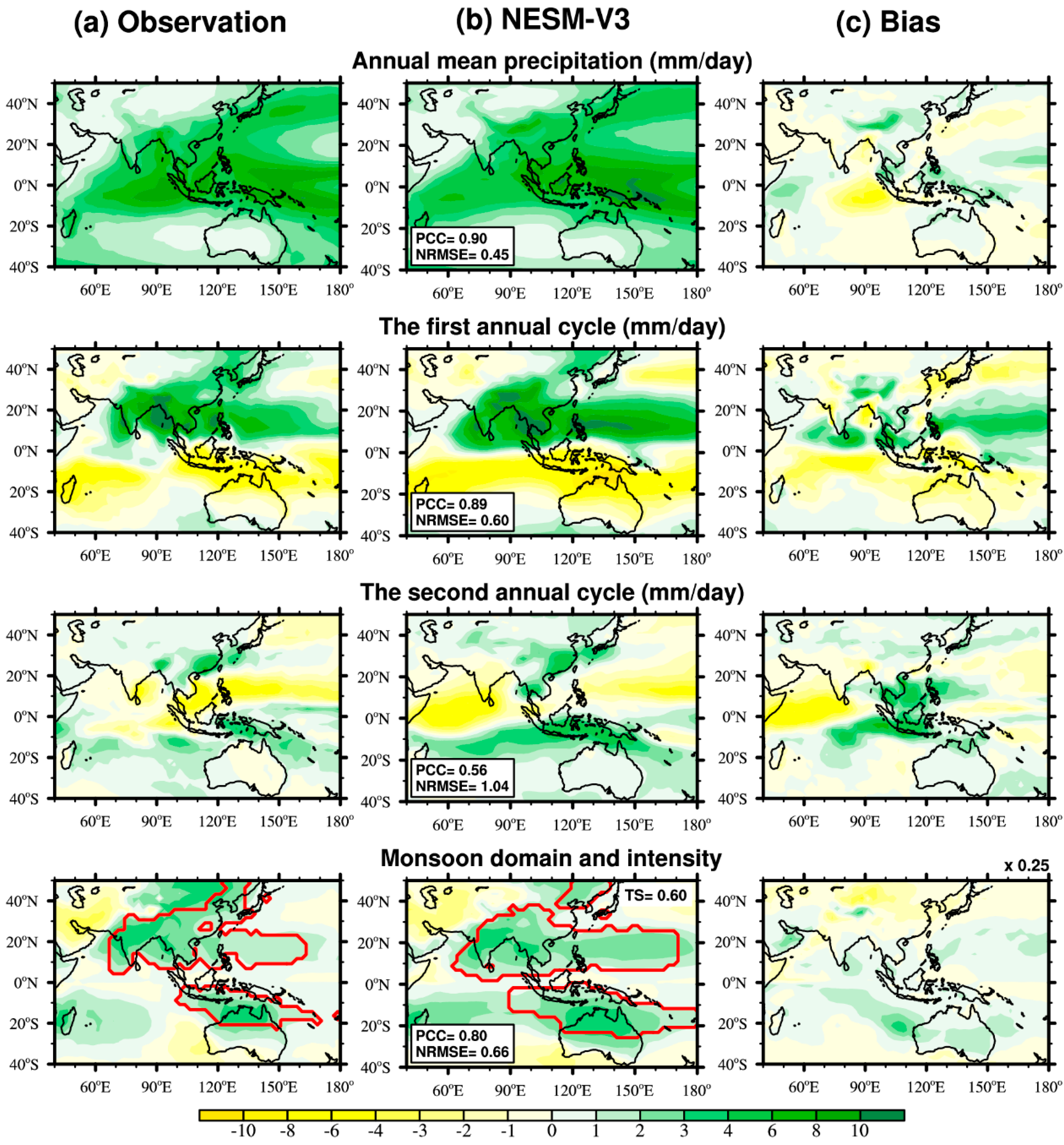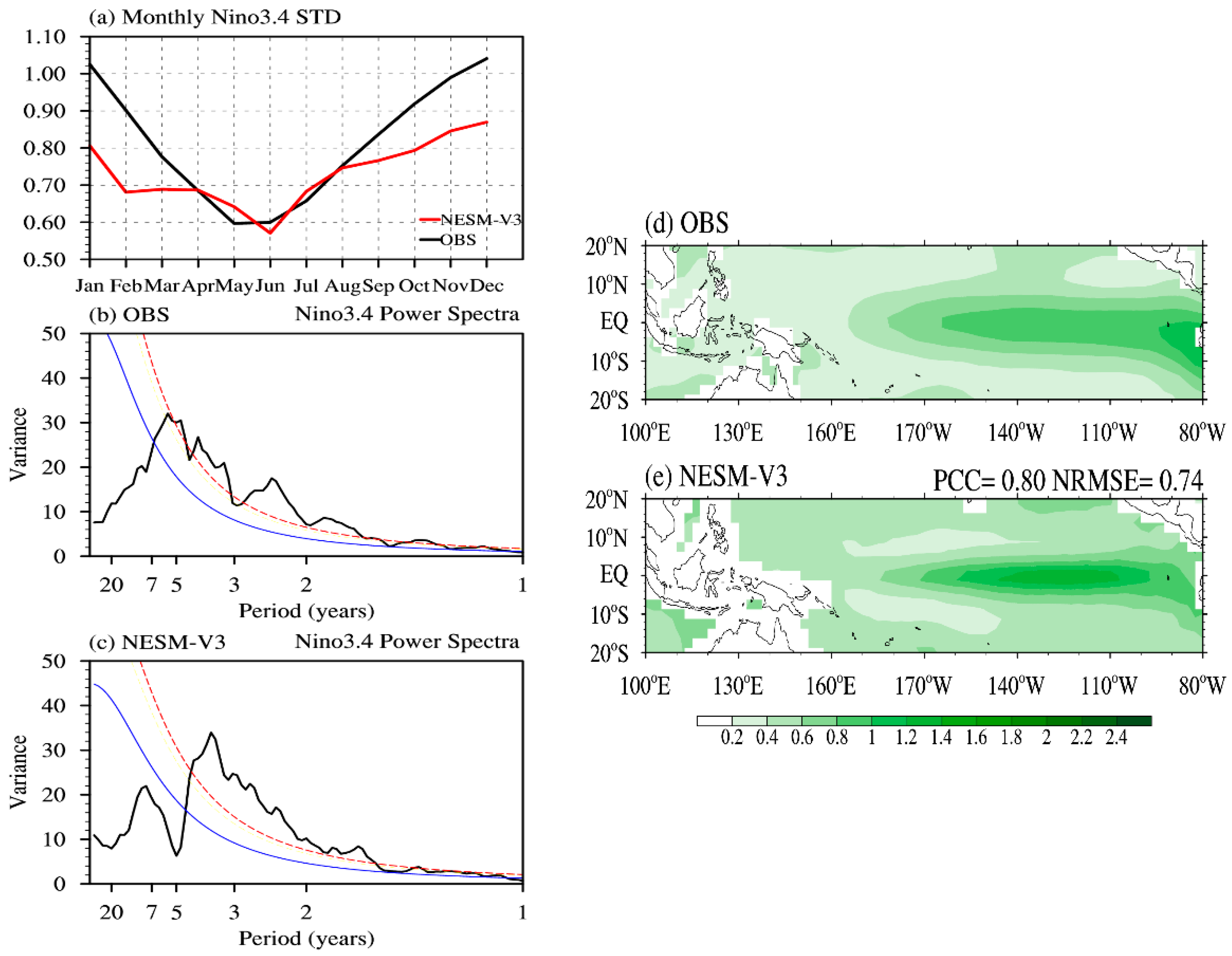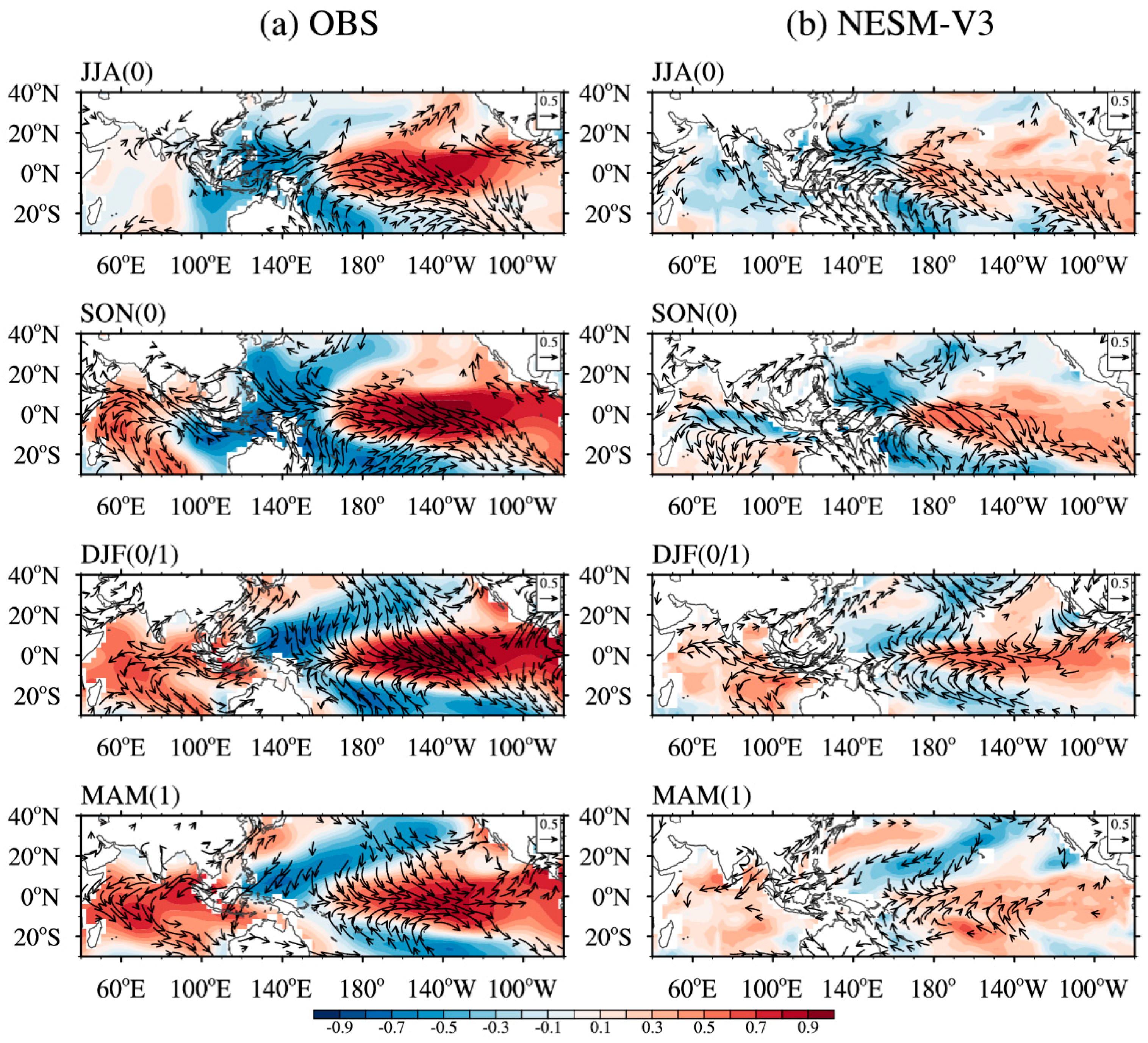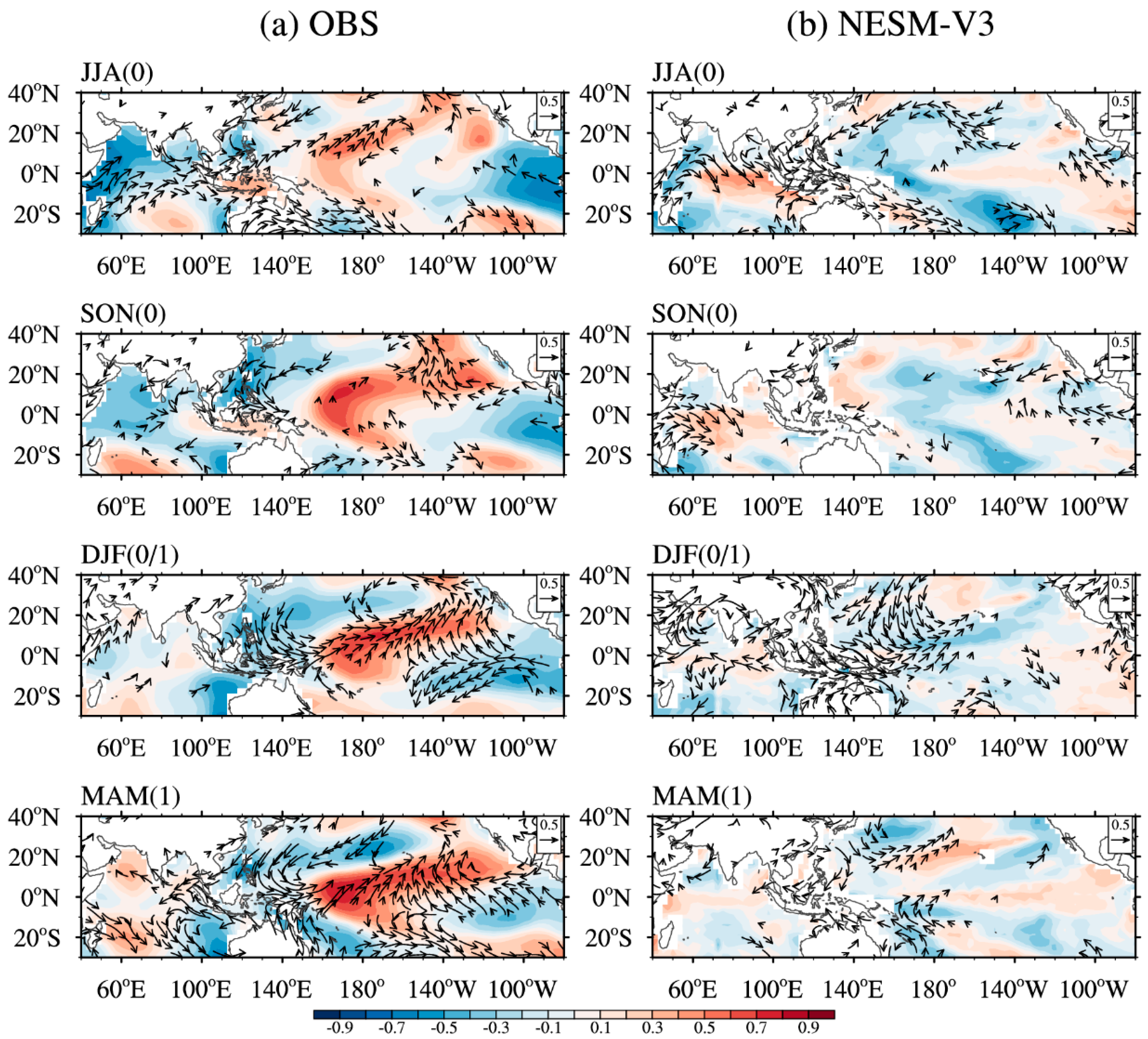Evaluation of NESMv3 and CMIP5 Models’ Performance on Simulation of Asian-Australian Monsoon
Abstract
:1. Introduction
2. Data, Model, and Method
2.1. Observed Data
2.2. Models
2.3. Objective Measures
3. Results
3.1. Monsoon Climatology
3.2. Year-To-Year Variability and Its Relationship with ENSO
4. Conclusions
Author Contributions
Funding
Acknowledgments
Conflicts of Interest
References
- Yasunari, T.; Seki, Y. Role of the Asian monsoon on the interannual variability of the global climate system. J. Meteorol. Soc. Jpn. Ser. II 1992, 70, 177–189. [Google Scholar] [CrossRef]
- Krishnamurti, T.N.; Bedi, H.S.; Subramaniam, M. The summer monsoon of 1988. Meteorol. Atmos. Phys. 1990, 42, 19–37. [Google Scholar] [CrossRef]
- Krishnamurti, T.; Bedi, H.S.; Subramaniam, M. The summer monsoon of 1987. J. Clim. 1989, 2, 321–340. [Google Scholar] [CrossRef]
- Webster, P.J.; Yang, S. Monsoon and enso: Selectively interactive systems. Q. J. R. Meteorol. Soc. 1992, 118, 877–926. [Google Scholar] [CrossRef]
- Webster, P.J.; Magaña, V.O.; Palmer, T.N.; Shukla, J.; Tomas, R.A.; Yanai, M.; Yasunari, T. Monsoons: Processes, predictability, and the prospects for prediction. J. Geophys. Res. 1998, 103, 14451–14510. [Google Scholar] [CrossRef] [Green Version]
- Wang, B.; Yang, J.; Zhou, T.; Wang, B. Interdecadal changes in the major modes of Asian-Australian monsoon variability: Strengthening relationship with ENSO since the late 1970s. J. Clim. 2008, 21, 1771–1789. [Google Scholar] [CrossRef]
- Wang, B.; Wu, R.; Li, T. Atmosphere–warm ocean interaction and its impacts on Asian–Australian monsoon variation. J. Clim. 2003, 16, 1195–1211. [Google Scholar] [CrossRef]
- Wang, B.; Kang, I.S.; Lee, J.Y. Ensemble simulations of Asian-Australian monsoon variability by 11 AGCMs. J. Clim. 2004, 17, 803–818. [Google Scholar] [CrossRef]
- Wu, R.; Kirtman, B.P. Roles of Indian and pacific ocean air–sea coupling in tropical atmospheric variability. Clim. Dyn. 2005, 25, 155–170. [Google Scholar] [CrossRef]
- Sperber, K.; Palmer, T.N. Interannual tropical rainfall variability in general circulation model simulations associated with the atmospheric model intercomparison project. J. Clim. 1996, 9, 2727–2750. [Google Scholar] [CrossRef]
- Meehl, G.A.; Arblaster, J.M. The Asian-Australian monsoon and EL Nino Southern Oscillation in the NCAR climate system. J. Clim. 1998, 11, 1356–1385. [Google Scholar] [CrossRef]
- Meehl, G.A.; Arblaster, J.M.; Lawrence, D. Monsoon regimes in the CCSM3. J. Clim. 2006, 19, 2482–2495. [Google Scholar] [CrossRef]
- Wang, B.; Lee, J.Y.; Kang, I.S.; Shukla, J.; Kug, J.S.; Kumar, A.; Schemm, J.; Luo, J.J.; Yamagata, T.; Park, C.K. How accurately do coupled climate models predict the leading modes of Asian-Australian monsoon interannual variability? Clim. Dyn. 2008, 30, 605–619. [Google Scholar] [CrossRef]
- Taylor, K.E.; Stouffer, R.J.; Meehl, G.A. An overview of CMIP5 and the experiment design. Bull. Am. Meteorol. Soc. 2012, 93, 485–498. [Google Scholar] [CrossRef]
- Wang, B.; Yim, S.-Y.; Lee, J.-Y.; Liu, J.; Ha, K.-J. Future change of Asian-Australian monsoon under RCP 4.5 anthropogenic warming scenario. Clim. Dyn. 2014, 42, 83–100. [Google Scholar] [CrossRef]
- Adler, R.F.; Huffman, G.J.; Chang, A.; Ferraro, R.; Xie, P.-P.; Janowiak, J.; Rudolf, B.; Schneider, U.; Curtis, S.; Bolvin, D.; et al. The version-2 global precipitation climatology project (GPCP) monthly precipitation analysis (1979–present). J. Hydrometeorol. 2003, 4, 1147–1167. [Google Scholar] [CrossRef]
- Xie, P.; Arkin, P.A. Global precipitation: A 17-year monthly analysis based on gauge observations, satellite estimates, and numerical model outputs. Bull. Am. Meteorol. Soc. 1997, 78, 2539–2558. [Google Scholar] [CrossRef]
- Lee, J.-Y.; Wang, B. Future change of global monsoon in the CMIP5. Clim. Dyn. 2014, 42, 101–119. [Google Scholar] [CrossRef]
- Huang, B.; Thorne, P.W.; Smith, T.M.; Liu, W.; Lawrimore, J.; Banzon, V.F.; Zhang, H.-M.; Peterson, T.C.; Menne, M. Further exploring and quantifying uncertainties for extended reconstructed sea surface temperature (ERSST) version 4 (v4). J. Clim. 2016, 29, 3119–3142. [Google Scholar] [CrossRef]
- Cao, J.; Wang, B.; Yang, Y.-M.; Ma, L.; Li, J.; Sun, B.; Bao, Y.; He, J.; Zhou, X. The nuist earth system model (NESM) version 3: Description and preliminary evaluation. Geosci. Model Dev. 2018, 11, 2975–2993. [Google Scholar] [CrossRef]
- Stevens, B.; Giorgetta, M.A.; Esch, M.; Mauritsen, T.; Crueger, T.; Rast, S.; Salzmann, M.; Schmidt, H.; Bader, J.; Block, K.; et al. The atmospheric component of the MPI-M earth system model: ECHAM6. J. Adv. Model. Earth Syst. 2013, 5, 146–172. [Google Scholar] [CrossRef]
- Madec, G. Nemo Ocean Engine; Note du Pole de modélisation; Institut Pierre-Simon Laplace (IPSL): Paris, France, 2008; Volume 27. [Google Scholar]
- Hunke, E.C.; Lipscomb, W.H. Cice: The Los Alamos Sea Ice Model Documentation and Software User’s Manual Version 4.1. La-cc-06-012; Los Alamos National Laboratory, T-3 Fluid Dynamics Group: Los Alamos, NM, USA, 2010.
- Craig, A.; Valcke, S.; Coquart, L. Development and performance of a new version of the OASIS coupler, OASIS3-MCT_3.0. Geosci. Model Dev. 2017, 10, 3297–3308. [Google Scholar] [CrossRef] [Green Version]
- Zhu, Z.; Li, T. The statistical extended-range (10–30-day) forecast of summer rainfall anomalies over the entire China. Clim. Dyn. 2017, 48, 209–224. [Google Scholar] [CrossRef]
- Zhu, Z.; Li, T. Statistical extended-range forecast of winter surface air temperature and extremely cold days over china. Q. J. R. Meteorol. Soc. 2017, 143, 1528–1538. [Google Scholar] [CrossRef]
- Wang, B.; Kim, H.J.; Kikuchi, K.; Kitoh, A. Diagnostic metrics for evaluation of annual and diurnal cycles. Clim. Dyn. 2011, 37, 941–955. [Google Scholar] [CrossRef]
- Yang, Y.-M.; Wang, B.; Li, J.; Cao, J.; Ma, L. Nuist earth system models v3. Part I: Formulation and historical simulation characteristics based on CMIP6 protocol. Geosci. Model Dev. 2018. in revision. [Google Scholar]
- Wang, B.; Ding, Q. Global monsoon: Dominant mode of annual variation in the tropics. Dyn. Atmos. Oceans 2008, 44, 165–183. [Google Scholar] [CrossRef]
- Zhu, Z.; He, J.; Qi, L. Seasonal transition of east Asian subtropical monsoon and its possible mechanism. J. Trop. Meteorol. 2012, 18, 305–311. [Google Scholar]
- Wang, B.; An, S.I. A method for detecting season-dependent modes of climate variability: S-EOF analysis. Geophys. Res. Lett. 2005, 32, L15710. [Google Scholar] [CrossRef]
- Turner, A.G.; Inness, P.M.; Slingo, J.M. The role of the basic state in the ENSO–monsoon relationship and implications for predictability. Q. J. R. Meteorol. Soc. 2006, 131, 781–804. [Google Scholar] [CrossRef]
- Hung, C.-W.; Liu, X.; Yanai, M. Symmetry and asymmetry of the Asian and Australian summer monsoons. J. Clim. 2004, 17, 2413–2426. [Google Scholar] [CrossRef]








| Model Designation | Institution | Resolution (Longitude × Latitude) |
|---|---|---|
| ACCESS1-0 | Commonwealth Scientific and Industrial Research Organisation and Bureau of Meteorology (CSIRO-BOM), Australia | 1.875° × 1.25° |
| BCC-CSM1.1-m | Beijing Climate Center, China Meteorological Administration (BCC), China | 1.125° × 1.125° |
| CanESM2 | Canadian Centre for Climate Modelling and Analysis (CCCma), Canada | 2.8125° × 2.8125° |
| CMCC-CESM CMCC-CMS | Centro Euro-Mediterraneo per I Cambiamenti Climatici (CMCC), Italy | 3.75° × 3.75° 1.875° × 1.875° |
| CNRM-CM5 | Centre National de Recherches Meteorologiques/Centre Europeen de Recherche et Formation Avancees en Calcul Scientifique (CNRM-CERFACS), France | 1.40625° × 1.40625° |
| CSIRO-Mk3-6-0 | Commonwealth Scientific and Industrial Research Organisation and the Queensland Climate Change Centre of Excellence (CSIRO-QCCCE), Australia | 1.875° × 1.875° |
| FGOALS-g2 | LASG, Institute of Atmospheric Physics, Chinease Academy of Sciences; and CESS, Tsinghua University (LASG-CESS), China | 2.8125° × 2.8125° |
| GFDL-ESM2M GFDL-ESM2G | Geophysical Fluid Dynamics Laboratory (NOAA GFDL), USA | 2.5° × 2° 2.5° × 2° |
| INM-CM4 | Institute for Numerical Mathematics (INM), Russia | 2° × 1.5° |
| IPSL-CM5A-LR IPSL-CM5A-MR IPSL-CM5B-LR | Institute Pierre-Simon Laplace (IPSL), France | 3.75° × 1.875° 2.5° × 1.258° 3.75° × 1.875° |
| MIROC5 MIROC-ESM-CHEM | Atmosphere and Ocean Research Institute (University of Tokyo), National Institute for Environmental Studies, and Japan Agency for Marine-Earth Science and Technology (MIROC), Japan | 1.40625° × 1.40625° 2.8125° × 2.8125° |
| MPI-ESM-LR MPI-ESM-P | Max Planck Institute for Meteorology (MPI-M), Germany | 1.875° × 1.875° 1.875° × 1.875° |
| MRI-CGCM3 | Meteorological Research Institute (MRI), Japan | 1.125° × 2.25° |
| NorESM1-M | Norwegian Climate Centre (NCC), Norway | 1.875° × 1.875° |
© 2018 by the authors. Licensee MDPI, Basel, Switzerland. This article is an open access article distributed under the terms and conditions of the Creative Commons Attribution (CC BY) license (http://creativecommons.org/licenses/by/4.0/).
Share and Cite
Li, J.; Yang, Y.-M.; Wang, B. Evaluation of NESMv3 and CMIP5 Models’ Performance on Simulation of Asian-Australian Monsoon. Atmosphere 2018, 9, 327. https://doi.org/10.3390/atmos9090327
Li J, Yang Y-M, Wang B. Evaluation of NESMv3 and CMIP5 Models’ Performance on Simulation of Asian-Australian Monsoon. Atmosphere. 2018; 9(9):327. https://doi.org/10.3390/atmos9090327
Chicago/Turabian StyleLi, Juan, Young-Min Yang, and Bin Wang. 2018. "Evaluation of NESMv3 and CMIP5 Models’ Performance on Simulation of Asian-Australian Monsoon" Atmosphere 9, no. 9: 327. https://doi.org/10.3390/atmos9090327
APA StyleLi, J., Yang, Y.-M., & Wang, B. (2018). Evaluation of NESMv3 and CMIP5 Models’ Performance on Simulation of Asian-Australian Monsoon. Atmosphere, 9(9), 327. https://doi.org/10.3390/atmos9090327





